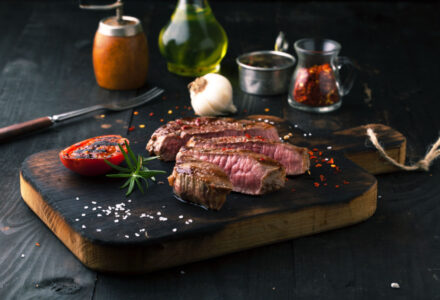This content has been archived. It may no longer be relevant
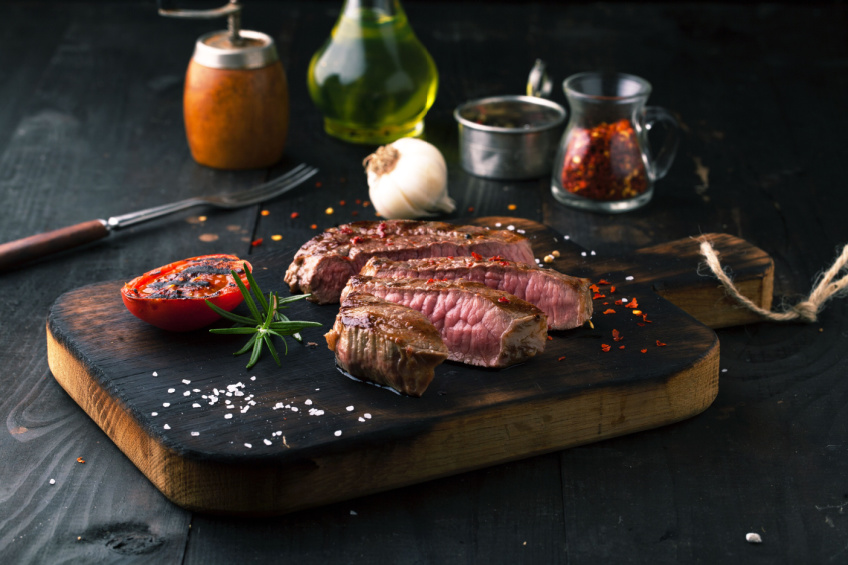 Grilling steak on a charcoal grill is a classic and time-honored cooking method that can result in deliciously smoky and juicy steaks.
Grilling steak on a charcoal grill is a classic and time-honored cooking method that can result in deliciously smoky and juicy steaks.
While it may seem intimidating to some, with the right techniques and preparation, you can achieve restaurant-quality results right in your own backyard.
In this guide, we will explore the step-by-step process of grilling steak on a charcoal grill, from choosing the right cuts of meat to mastering the art of charcoal grilling.
Getting Started – Choosing the Right Steak Cuts and Prepping Your Charcoal Grill
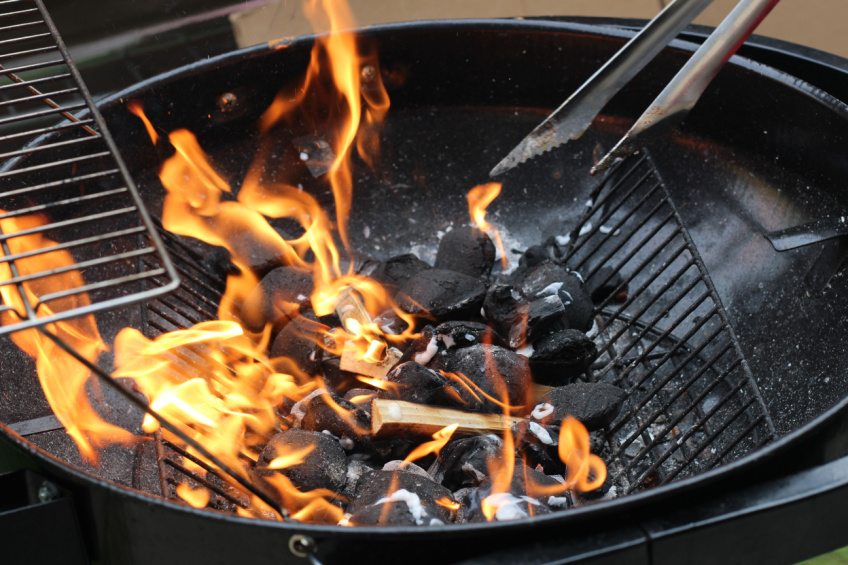
Choosing the right steak cuts and prepping your charcoal grill are important steps to ensure a delicious and perfectly cooked steak.
Here’s a step-by-step guide to get you started.
Choosing the right steak cuts
- Ribeye. This cut comes from the rib section of the cow and is known for its rich marbling, which makes it juicy and flavorful. It’s a popular choice for grilling due to its tenderness and excellent flavor.
- New York strip. Also known as a strip steak or a sirloin steak, this cut comes from the short loin section of the cow. It’s known for its firm texture and bold flavor.
- Filet mignon. This cut comes from the tenderloin, which is a muscle that doesn’t do much work, resulting in a very tender piece of meat. It has a mild flavor and is often considered the most tender cut of steak.
- T-bone. This cut comes from the rear of the cow and has a characteristic T-shaped bone in the middle, with a strip steak on one side and a small piece of tenderloin on the other. It’s a great option if you want to enjoy both the strip steak and tenderloin in one cut.
Prepping your charcoal grill
- Clean the grill grates. Start by cleaning the grill grates with a wire brush to remove any leftover food or debris from previous grilling sessions. This will ensure that your steaks don’t stick to the grates and will get those beautiful grill marks.
- Charcoal arrangement. Arrange your charcoal briquettes in a pyramid shape or use a charcoal chimney starter to light the charcoal. Once the charcoal is lit and covered with white ash, spread them evenly across the bottom of the grill, creating a two-zone fire with one side having more charcoal for high heat and the other side having fewer coals for indirect heat.
- Preheat the grill. Put the grates back on the grill and cover with the lid. Let the grill preheat for about 10-15 minutes until the grates are hot and ready for cooking.
Seasoning and preparing your steaks
- Season your steaks. Generously season your steaks with salt and pepper on both sides, or use your favorite steak seasoning for added flavor. You can also marinate your steaks for a few hours prior to grilling for extra flavor.
- Bring steaks to room temperature. Take your steaks out of the refrigerator and let them come to room temperature for about 30 minutes before grilling. This will ensure that the steaks cook evenly.
- Pat dry. Before grilling, pat your steaks dry with a paper towel to remove any excess moisture. This will help with searing and developing a nice crust on the steak.
Grilling your steaks
- Searing. Place your steaks directly over the high-heat zone of the charcoal grill and sear for 2-3 minutes per side, or until you get grill marks and a nice crust.
- Moving to indirect heat. Move the steaks to the low-heat zone of the grill, away from direct flames, and continue grilling with the lid closed for another 5-10 minutes per side, depending on your desired level of doneness.
- Checking the internal temperature. Use a meat thermometer to check the internal temperature of your steaks. For medium-rare, aim for 135°F (57°C), medium for 145°F (63°C), and medium-well for 150°F (66°C). Remember to insert the thermometer into the thickest part of the steak without touching the bone.
- Resting. Once your steaks reach the desired internal temperature, remove them from the grill and let them rest for a few minutes.
Essential Tools and Ingredients for Grilling the Perfect Steak on Charcoal
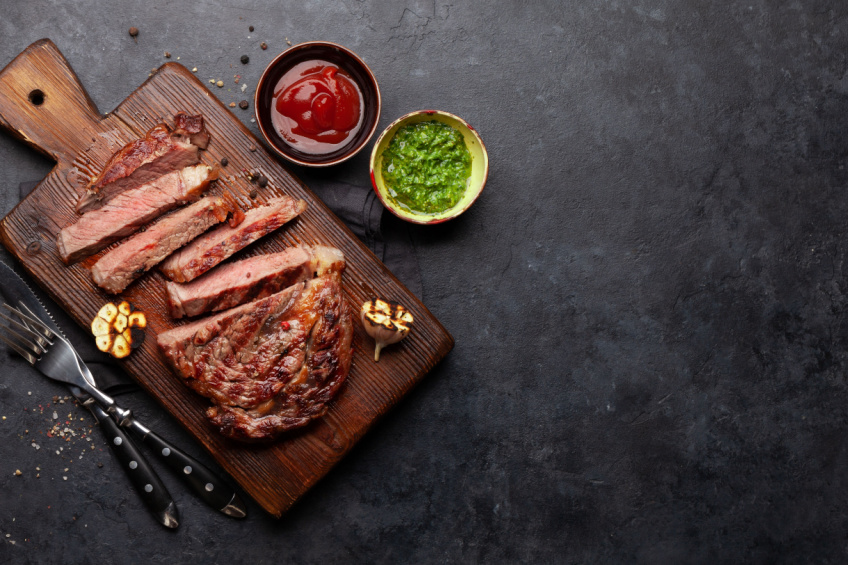
Grilling the perfect steak on charcoal requires some essential tools and ingredients to ensure success.
Here’s a list of what you’ll need.
Tools
- Charcoal grill. You’ll need a charcoal grill to create that authentic smoky flavor in your steak. Choose a high-quality charcoal grill that suits your needs and budget.
- Charcoal chimney starter. This is a metal cylinder used to light charcoal briquettes quickly and evenly without using lighter fluid. It’s a must-have tool for charcoal grilling.
- Grill grates brush. You’ll need a grill grates brush to clean the grates before and after grilling to prevent sticking and ensure nice grill marks on your steak.
- Meat thermometer. A reliable meat thermometer is essential for checking the internal temperature of your steak to achieve the desired level of doneness.
- Tongs or spatula. You’ll need a good pair of tongs or a spatula to handle the steaks on the grill, flip them, and move them around as needed.
- Aluminum foil. Aluminum foil can be used to wrap the steaks and let them rest after grilling, which helps to retain their juices and keep them moist.
Ingredients
- High-quality steak cuts. Choose the right steak cuts based on your preferences, such as ribeye, New York strip, filet mignon, or T-bone. Look for well-marbled steaks with good fat content for maximum flavor and tenderness.
- Salt and pepper. Simple seasoning with salt and pepper enhances the natural flavor of the steak. Use coarse salt and freshly ground black pepper for the best results.
- Optional. Steak seasoning or marinade: You can use your favorite steak seasoning or marinade to add additional flavor to your steak. There are many commercially available options or you can make your own with herbs, spices, and other ingredients.
- Optional. Olive oil or melted butter. You can brush some olive oil or melted butter on your steaks before grilling to add flavor and prevent them from sticking to the grill grates.
With these essential tools and ingredients, you’ll be well-equipped to grill the perfect steak on charcoal and impress your guests with delicious, juicy, and flavorful results.
Step-by-Step Guide – How to Light and Manage Charcoal for Steak Grilling
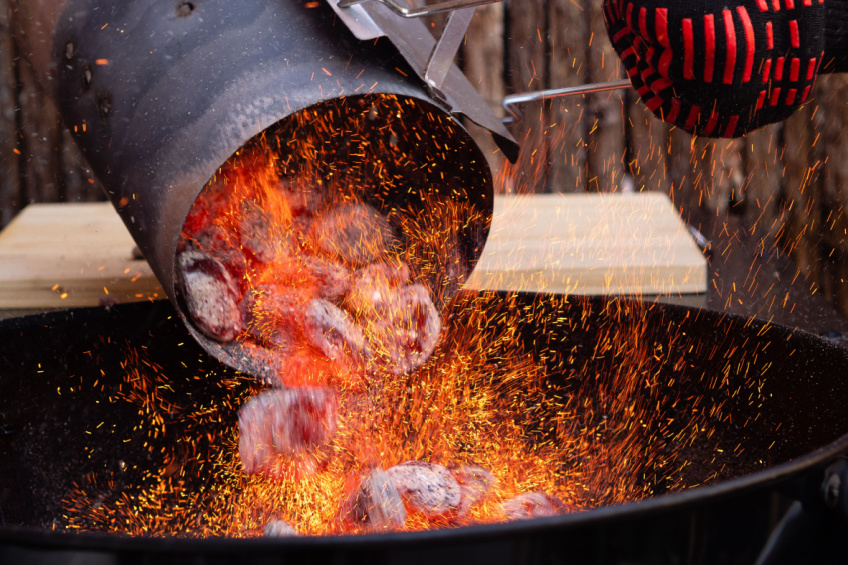 Grilling steak on charcoal requires proper lighting and management of charcoal to achieve the perfect results.
Grilling steak on charcoal requires proper lighting and management of charcoal to achieve the perfect results.
Here’s a step-by-step guide on how to light and manage charcoal for steak grilling.
- Choose the right charcoal and quantity
Choose high-quality charcoal briquettes or lump charcoal for grilling. Briquettes are more consistent in size and burn longer, while lump charcoal provides a more natural, smoky flavor. Determine the amount of charcoal you need based on the size and thickness of your steaks, as well as the desired cooking temperature. As a general rule, use about 30 briquettes or a handful of lump charcoal per pound of meat.
- Prepare the charcoal grill
Ensure that your charcoal grill is clean and free of ashes from previous grilling sessions. Open the vents at the bottom of the grill to allow air to flow and facilitate the charcoal lighting process. Place a drip pan under the grill grates to catch any drippings from the steak and prevent flare-ups.
- Light the charcoal
Use a charcoal chimney starter to light the charcoal. Fill the chimney starter with the desired amount of charcoal, and place crumpled newspaper or fire starters underneath. Light the newspaper or fire starters, and let the charcoal burn until it’s covered with white ash, which usually takes about 15-20 minutes. Avoid using lighter fluid, as it can impart a chemical taste to the steak.
- Spread the lit charcoal
Once the charcoal is lit and covered with white ash, carefully pour it onto one side of the charcoal grill, creating a two-zone fire. This means you’ll have a hot direct heat zone on one side for searing the steak and a cooler indirect heat zone on the other side for finishing the cooking process.
By following these steps, you’ll be able to light and manage charcoal for steak grilling like a pro, resulting in mouthwatering, juicy, and flavorful steaks that
Achieving the Perfect Steak – Tips for Seasoning, Marinating, and Resting
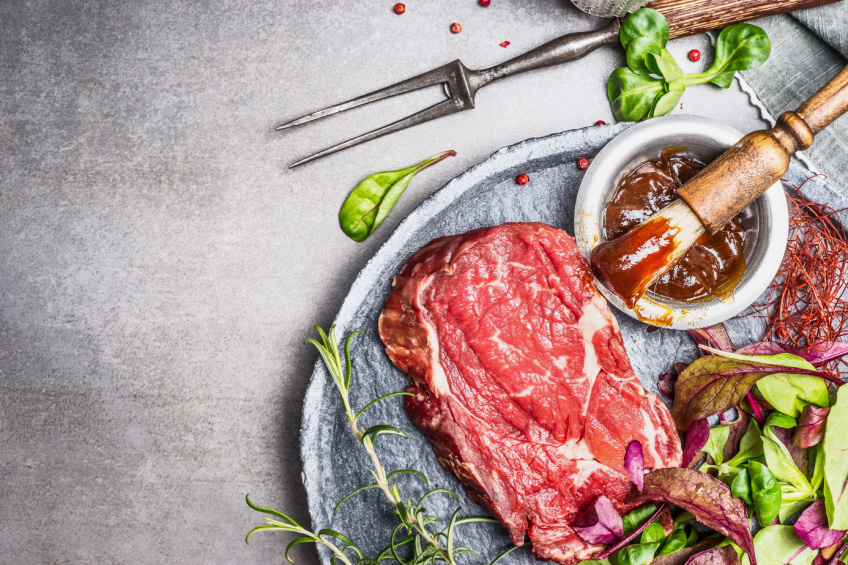 Seasoning, marinating, and resting are key steps in achieving the perfect steak on a charcoal grill. Here are some tips to help you master these techniques:
Seasoning, marinating, and resting are key steps in achieving the perfect steak on a charcoal grill. Here are some tips to help you master these techniques:
- Seasoning. Use salt generously to season your steaks. Salt helps to enhance the natural flavors of the meat and creates a delicious crust when grilled. You can also add other seasonings such as black pepper, garlic powder, or herbs to add more depth of flavor to your steaks. Be sure to season both sides of the steak and let it sit at room temperature for about 30 minutes before grilling to allow the seasoning to penetrate the meat.
- Marinating. Marinating is a great way to add additional flavors to your steaks. You can use a variety of marinades, such as a simple combination of oil, acid (such as vinegar or citrus juice), and herbs/spices. Marinate your steaks in the refrigerator for at least 30 minutes, or overnight for a more intense flavor. Be sure to pat the steaks dry before grilling to prevent flare-ups.
- Resting. Resting is a crucial step in ensuring a juicy and flavorful steak. After grilling, let your steaks rest for about 5 minutes tented loosely with aluminum foil. This allows the juices to redistribute, resulting in a more tender and juicy steak. Avoid cutting into the steaks immediately after grilling, as it can cause the juices to escape, resulting in a drier steak.
- Experiment with different seasonings and marinades. Don’t be afraid to get creative with your seasonings and marinades. Try different combinations of herbs, spices, oils, acids, and even liquids like beer or wine to infuse unique flavors into your steaks. You can also experiment with different types of salts, such as kosher salt or sea salt, to add different textures and flavors to your steaks.
- Consider dry-brining. Dry-brining is a technique where you generously salt your steaks and let them rest in the refrigerator for a few hours or overnight. The salt draws out the moisture from the steak and then gets reabsorbed, resulting in a more flavorful and tender steak. This can be a great alternative to marinating, especially if you prefer a simpler approach.
- Use a meat thermometer. Investing in a good-quality meat thermometer is essential for achieving the perfect steak. It allows you to monitor the internal temperature of the steak and ensures that it’s cooked to your desired level of doneness. This helps to prevent overcooking or undercooking, resulting in a perfectly cooked steak.
- Experiment with resting times. Resting times can vary depending on the thickness of your steaks and your personal preference. You can adjust the resting time based on how well-done you like your steaks. For rare to medium-rare steaks, 5 minutes of resting is usually sufficient. For medium to well-done steaks, you can increase the resting time to 10 minutes or more.
By following these tips for seasoning, marinating, and resting, you’ll be able to elevate the flavors of your steaks and achieve a perfect, juicy, and delicious meal on your charcoal grill.
The Art of Charcoal Grilling – Techniques for Achieving the Perfect Sear and Grill Marks
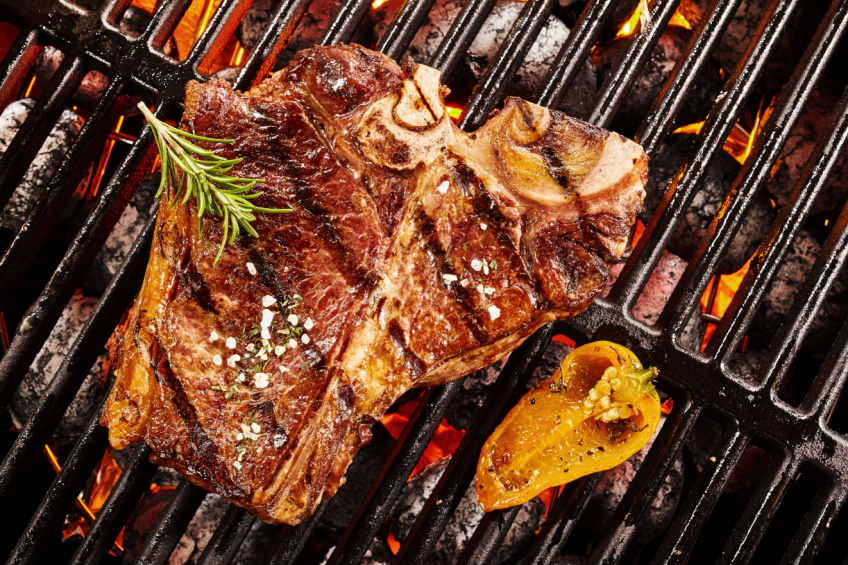 Achieving the perfect sear and grill marks on your steak is an art form that can take your charcoal grilling to the next level.
Achieving the perfect sear and grill marks on your steak is an art form that can take your charcoal grilling to the next level.
Here are some techniques to help you achieve that beautiful sear and grill marks.
- Preheat your charcoal grill. Properly preheating your charcoal grill is crucial to achieving a good sear and grill marks on your steak. Allow the charcoal to fully ash over and reach a high heat, usually around 400-450°F (204-232°C) for searing. This ensures that the grates are hot enough to create a sear and grill marks on the steak.
- Use the two-zone grilling method. The two-zone grilling method involves creating two different heat zones on your charcoal grill – a direct heat zone and an indirect heat zone. The direct heat zone is where you sear the steak, and the indirect heat zone is where you move the steak after searing to continue cooking to your desired level of doneness. This allows you to sear the steak quickly to create grill marks and then finish cooking it to perfection.
- Oil the grates and the steak. Before placing the steak on the grill, lightly oil the grates with a high-heat cooking oil to prevent the steak from sticking. You can use a brush or a folded paper towel soaked in oil to coat the grates. You should also lightly coat the steak with oil on both sides to help promote the sear and prevent it from drying out.
- Sear the steak on high heat. Once the grill is preheated, place the steak directly over the high heat zone and let it sear for a few minutes on each side without moving it. This creates a caramelized crust on the steak, which adds flavor and creates grill marks. Avoid flipping the steak too frequently, as it can prevent proper searing. Use tongs to flip the steak, as piercing it with a fork can cause juices to escape.
- Use the diagonal grill mark technique. To achieve those classic diagonal grill marks, you can rotate the steak 45 degrees after the first sear on one side, and then again after the second sear on the other side. This creates a crisscross pattern on the steak, adding a visually appealing touch to your grilled masterpiece.
- Move to indirect heat to finish cooking. After searing the steak on both sides, move it to the indirect heat zone of the grill to finish cooking to your desired level of doneness. This allows the steak to cook more evenly and prevents it from becoming overly charred. Use a meat thermometer to monitor the internal temperature and remove the steak from the grill when it reaches your desired level of doneness.
- Let it rest before slicing. After grilling, let the steak rest for a few minutes to allow the juices to redistribute before slicing into it. This helps to retain the moisture and ensures a juicy and flavorful steak.
With practice and attention to these techniques, you can achieve a beautiful sear and grill marks on your steak, creating an impressive presentation and enhancing the flavors of your grilled masterpiece.
Enjoy your perfectly seared and grilled steak!
Monitoring Doneness – Using Thermometers and Timers for Perfectly Cooked Steaks
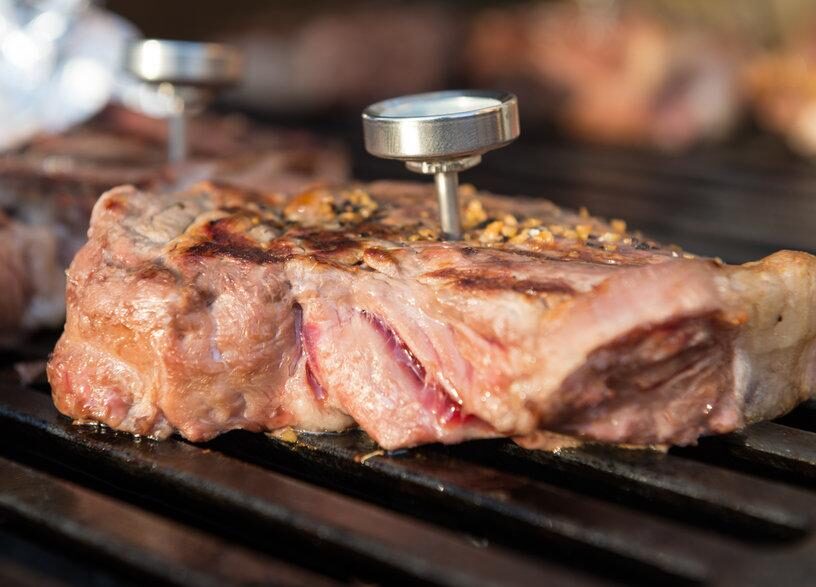
Monitoring the doneness of your steak is crucial to achieving perfectly cooked steaks on your charcoal grill.
Here are some tips on how to use thermometers and timers to ensure your steaks are cooked to perfection.
- Meat thermometer. A meat thermometer is a reliable tool to monitor the internal temperature of your steak and determine its doneness. There are two types of meat thermometers that you can use for grilling: instant-read thermometers and leave-in thermometers.
- Instant-read thermometers. These thermometers provide quick and accurate readings and are inserted into the thickest part of the steak to check its internal temperature. Insert the thermometer into the side of the steak, avoiding bone or fat, and wait for a few seconds until the reading stabilizes. The temperature reading will indicate the doneness of the steak. For example, for medium-rare, the internal temperature should be around 130-135°F (54-57°C), medium around 140-145°F (60-63°C), and medium-well around 150-155°F (66-68°C).
- Leave-in thermometers. These thermometers are inserted into the steak before it goes on the grill and are left in place throughout the cooking process. They have a probe attached to a cable that connects to a thermometer display outside the grill, allowing you to monitor the temperature without opening the grill. This minimizes the risk of overcooking or undercooking the steak.
- Timer. Using a timer is another important tool for monitoring the doneness of your steak. Keep track of the time the steak has been cooking on each side to ensure even cooking. Timers can be set on your grill, your phone, or any other device you have on hand. Follow a recommended cooking time chart for your desired level of doneness, and adjust as needed based on the thickness of your steak and the temperature of your grill.
- Resting time. Resting your steak after grilling is also a crucial step in achieving perfectly cooked steaks. During resting, the internal temperature of the steak continues to rise, and the juices redistribute, resulting in a more tender and flavorful steak. Use a timer to rest your steak for at least 5 minutes, but up to 10 minutes for thicker cuts, before slicing into it.
By using meat thermometers, timers, and resting time, you can ensure that your steaks are cooked to your desired level of doneness, whether it’s medium-rare, medium, or medium-well.
This will help you achieve perfectly cooked steaks with optimal flavor and juiciness, making your charcoal grilling experience even more enjoyable.
Mastering Different Steak Cuts – Cooking Ribeye, Filet Mignon, New York Strip, and More
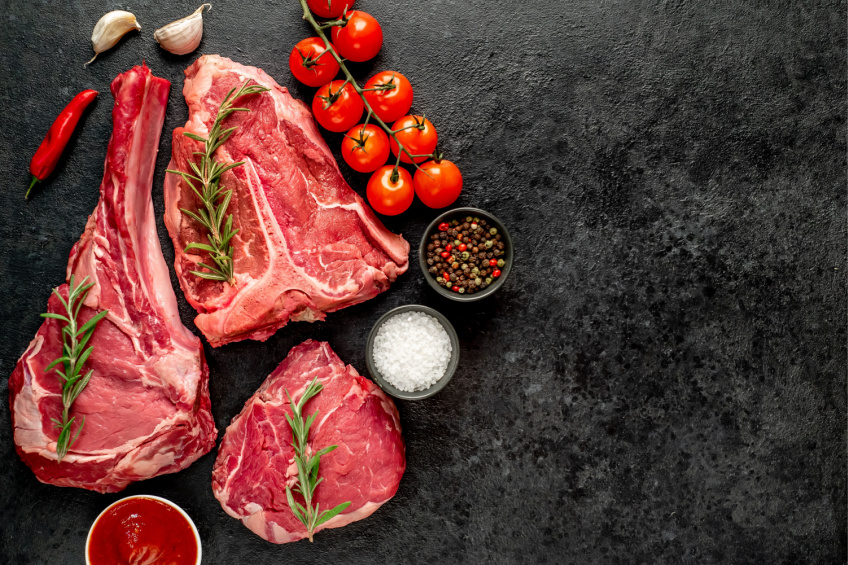
Mastering different steak cuts requires understanding the unique characteristics of each cut and adjusting your grilling techniques accordingly.
Here are some tips for cooking popular steak cuts, such as ribeye, filet mignon, New York strip, and more on a charcoal grill.
- Ribeye. Ribeye steaks are known for their marbling, which makes them juicy and flavorful. To cook a ribeye steak on a charcoal grill, follow these steps:
- Season the ribeye steak with salt and pepper or your preferred steak seasoning.
- Preheat your charcoal grill to medium-high heat for direct grilling.
- Place the ribeye steak on the hot grill grates and sear each side for 3-4 minutes to develop a crust.
- Move the ribeye steak to indirect heat and continue grilling until it reaches your desired internal temperature using a meat thermometer (e.g., 130-135°F for medium-rare).
- Let the ribeye steak rest for a few minutes before slicing and serving.
- Filet Mignon. Filet mignon is a tender cut that is leaner compared to ribeye or New York strip. To cook a filet mignon on a charcoal grill, follow these steps:
- Season the filet mignon steak with salt and pepper or your preferred steak seasoning.
- Preheat your charcoal grill to medium-high heat for direct grilling.
- Place the filet mignon steak on the hot grill grates and sear each side for 2-3 minutes to develop a crust.
- Move the filet mignon steak to indirect heat and continue grilling until it reaches your desired internal temperature using a meat thermometer (e.g., 135-140°F for medium).
- Let the filet mignon steak rest for a few minutes before slicing and serving.
- New York Strip. New York strip steaks are known for their balance of tenderness and flavor. To cook a New York strip steak on a charcoal grill, follow these steps:
- Season the New York strip steak with salt and pepper or your preferred steak seasoning.
- Preheat your charcoal grill to medium-high heat for direct grilling.
- Place the New York strip steak on the hot grill grates and sear each side for 3-4 minutes to develop a crust.
- Move the New York strip steak to indirect heat and continue grilling until it reaches your desired internal temperature using a meat thermometer (e.g., 130-135°F for medium-rare).
- Let the New York strip steak rest for a few minutes before slicing and serving.
- Other cuts. Different cuts of steak may require different cooking techniques and times. For example, T-bone and porterhouse steaks, which contain both a strip steak and a filet mignon separated by a bone, may require a combination of direct and indirect grilling to ensure even cooking of both cuts. Thicker cuts like tomahawk steaks may require longer cooking times and a reverse-sear method, where the steak is first cooked on indirect heat and then seared over high heat to finish.
Remember to always use a meat thermometer to check the internal temperature of your steaks and adjust your cooking time accordingly to achieve your desired level of doneness.
Resting your steaks after grilling is also important to allow the juices to redistribute and ensure a more flavorful and tender result.
With practice and experimentation, you’ll be able to master cooking different steak cuts on a charcoal grill to perfection.
Elevating Your Steak Game – Advanced Techniques and Flavor Enhancements
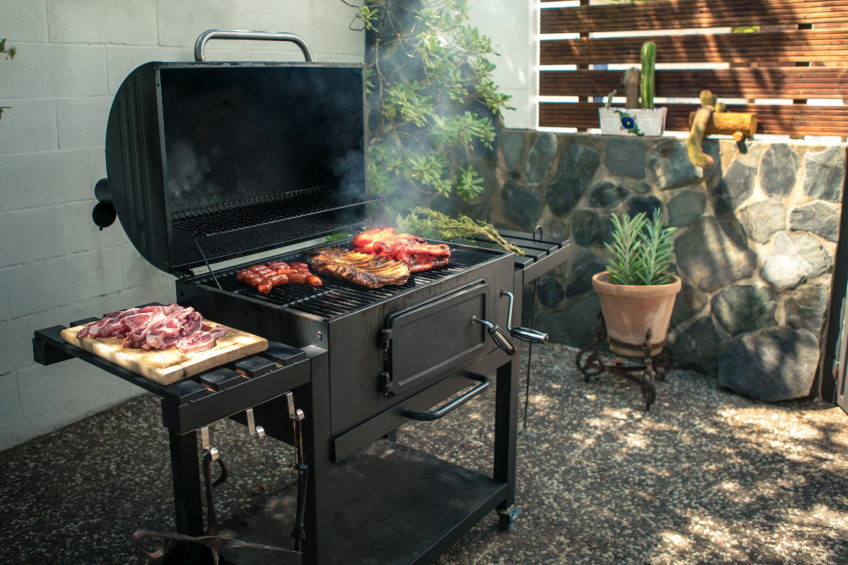
Once you’ve mastered the basics of grilling steak on a charcoal grill, you can take your steak game to the next level by trying some advanced techniques and flavor enhancements.
Here are some ideas to elevate your steak game.
- Reverse Sear. Reverse searing is a technique where you first cook the steak on indirect heat to slowly bring it to your desired internal temperature, and then finish with a high-heat sear for a crusty exterior. This method can result in a more evenly cooked steak with a flavorful crust. To reverse sear, follow these steps:
- Season your steak with salt, pepper, and any other desired seasonings.
- Set up your charcoal grill for indirect grilling by pushing the charcoal to one side of the grill or creating a two-zone fire.
- Place the steak on the cooler side of the grill, away from the direct heat, and cook it slowly until it reaches about 10-15°F below your desired internal temperature.
- Move the steak to the hot side of the grill and sear each side for 1-2 minutes until you achieve a crusty sear.
- Use a meat thermometer to check the internal temperature of the steak and let it rest for a few minutes before slicing and serving.
- Herb Butter Basting. Basting your steak with herb-infused butter can add extra flavor and richness to your steak. To do this, follow these steps:
- Prepare a herb-infused butter by mixing softened butter with minced garlic, fresh herbs (such as rosemary, thyme, and parsley), salt, and pepper.
- Season your steak with salt and pepper or your preferred steak seasoning.
- Grill your steak on direct heat, flipping occasionally, until it reaches your desired internal temperature.
- During the last few minutes of cooking, start basting your steak with the herb-infused butter using a brush or spoon.
- Continue to baste the steak while it rests for a few minutes before serving.
- Smoke Infusion. Adding smoke flavor to your steak can create a unique and delicious taste profile. To infuse smoke flavor, follow these steps:
- Soak wood chips (such as hickory, mesquite, or cherry) in water for about 30 minutes before grilling.
- Prepare your charcoal grill for indirect grilling.
- Season your steak with salt, pepper, and any other desired seasonings.
- Drain the soaked wood chips and place them directly on the hot charcoal to create smoke.
- Place the steak on the cooler side of the grill, away from the direct heat, and cook it slowly until it reaches your desired internal temperature.
- Let the steak rest for a few minutes before serving.
- Marinades. Marinating your steak can add flavor and help tenderize the meat. To use a marinade, follow these steps:
- Prepare a marinade by combining your desired ingredients, such as oil, acid (such as vinegar or citrus juice), herbs, spices, and aromatics (such as garlic and onions).
- Place your steak in a shallow dish and pour the marinade over it, making sure it’s completely coated. You can also use a resealable plastic bag for easy marinating.
- Cover the dish or seal the bag and refrigerate the steak for at least 30 minutes to several hours, depending on the desired flavor intensity and the thickness of the steak.
- Remove the steak from the marinade and let any excess marinade drip off before grilling.
- Grill the steak on direct heat, flipping occasionally, until it reaches your desired internal temperature.
- Let the steak rest for a few minutes before serving.
- Compound Butter. Compound butter is a mixture of butter and flavorings that can be used to add richness and depth of flavor to your steak. To make compound butter, simply mix softened butter with herbs, spices, garlic, or other flavorings of your choice. Roll the butter mixture into a log shape, wrap it in plastic wrap, and chill it in the refrigerator until firm. When your steak is cooked and resting, slice a disc of compound butter and place it on top of the hot steak to melt and create a delicious buttery sauce.
By incorporating these advanced techniques and flavor enhancements, you can take your grilled steak to the next level and impress your guests with even more delicious and flavorful results.
Don’t be afraid to experiment with different herbs, spices, marinades, and compound butters to create your own unique steak creations.
Troubleshooting and FAQs. Common Mistakes to Avoid When Grilling Steak on Charcoal
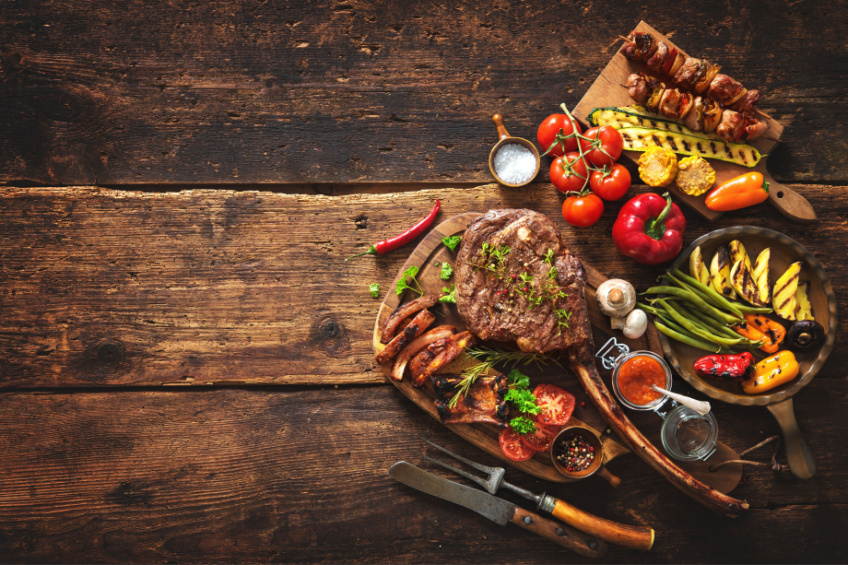
Grilling steak on charcoal can be a rewarding experience, but it’s important to avoid common mistakes that can impact the quality and taste of your steak.
Here are some troubleshooting tips and frequently asked questions (FAQs) to help you avoid mistakes and achieve perfect results.
- Mistake. Not letting the charcoal properly heat up – One common mistake is not allowing enough time for the charcoal to fully heat up before placing the steak on the grill. This can result in uneven cooking and a less desirable sear.
Solution. Make sure to properly light and heat your charcoal until it’s covered with white ash before placing the steak on the grill. This can take about 20-30 minutes depending on the type and size of your charcoal. Use a charcoal chimney starter or electric starter to ensure even heating.
- Mistake. Overcooking or undercooking the steak – Achieving the perfect level of doneness can be challenging, especially if you’re not using a meat thermometer or are unfamiliar with the cooking times for different steak cuts.
Solution. Invest in a good-quality meat thermometer to accurately measure the internal temperature of your steak and ensure it’s cooked to your desired level of doneness. Follow recommended cooking times and temperatures for different steak cuts, and practice using the thermometer to determine the perfect doneness for your preference.
- Mistake. Not properly seasoning or resting the steak – Seasoning and resting are crucial steps in grilling a flavorful and juicy steak. Skipping these steps can result in a bland or dry steak.
Solution. Season your steak generously with salt, pepper, and any other desired seasonings before grilling. Let the seasoned steak rest at room temperature for about 30 minutes before grilling to allow the flavors to penetrate the meat. After grilling, let the steak rest for a few minutes before cutting into it to allow the juices to redistribute and ensure a juicy steak.
- Mistake. Opening the grill too frequently – Opening the grill too frequently can result in loss of heat and inconsistent cooking, as well as prolonging the cooking time.
Solution. Avoid opening the grill too frequently during cooking, especially when searing the steak. Keep the lid closed as much as possible to maintain a consistent cooking temperature and avoid loss of heat.
- Mistake. Using lighter fluid or excess charcoal – Using lighter fluid or adding too much charcoal can result in a strong chemical taste on the steak.
Solution. Avoid using lighter fluid to light your charcoal, as it can impart a chemical taste to your steak. Instead, use a chimney starter or electric starter to light your charcoal. Also, avoid overcrowding the grill with excessive charcoal, as it can cause flare-ups and uneven cooking. Use the appropriate amount of charcoal based on the size and type of your grill.
- Mistake. Cutting into the steak too soon – Cutting into the steak immediately after grilling can cause the juices to escape and result in a dry steak.
Solution. Allow the steak to rest for a few minutes after grilling before cutting into it. This allows the juices to redistribute and results in a juicier and more flavorful steak.
Frequently Asked Questions (FAQs)
- How do I know when my steak is done?
Use a meat thermometer to measure the internal temperature of your steak. The following internal temperatures are recommended for different levels of doneness: 125°F for rare, 130-135°F for medium-rare, 140°F for medium, 150°F for medium-well, and 160°F for well-done.
- How do I get perfect grill marks on my steak?
To achieve perfect grill marks, make sure your grill grates are clean and well-seasoned. Place the steak diagonally on the grates and leave it undisturbed for a few minutes to create grill marks.
- Can I marinate my steak before grilling it on charcoal?
Yes, marinating can add flavor to your steak. However, avoid using marinades with high sugar content as they can cause flare-ups and charring on the grill. Also, pat the steak dry before placing it on the grill to avoid excess moisture that can hinder the formation of a good crust.
- How do I prevent flare-ups on my charcoal grill?
Flare-ups can occur when fat drips onto the hot charcoal, causing sudden bursts of flames. To prevent flare-ups, trim excess fat from your steak, avoid using marinades with high sugar content, and position the steak away from direct flames. You can also have a spray bottle of water on hand to quickly extinguish any flare-ups.
- Can I use wood chips or chunks for additional flavor when grilling on charcoal?
Yes, adding wood chips or chunks to your charcoal can infuse your steak with additional smoky flavor. Soak the wood chips or chunks in water for about 30 minutes before adding them to the charcoal. Place them on top of the hot charcoal and let them smolder to release smoke while grilling your steak.
- What should I do if my steak is cooking too quickly or too slowly on the charcoal grill?
If your steak is cooking too quickly, raise the grilling grate or move the steak to a cooler part of the grill. If it’s cooking too slowly, move it to a hotter part of the grill or add more charcoal to increase the heat. Monitoring the temperature and adjusting the placement of the steak on the grill can help you achieve the desired cooking speed.
- Can I reuse charcoal for multiple grilling sessions?
Yes, if you have leftover charcoal that is not fully burned, you can reuse it for future grilling sessions. Simply shake off any ash and store the remaining charcoal in a dry place for future use. Before reusing, you may need to add some fresh charcoal to ensure sufficient heat for grilling.
I hope these troubleshooting tips and FAQs help you avoid common mistakes and achieve perfect results when grilling steak on charcoal.
Safety First – Best Practices for Grilling Steak on Charcoal and Avoiding Accidents
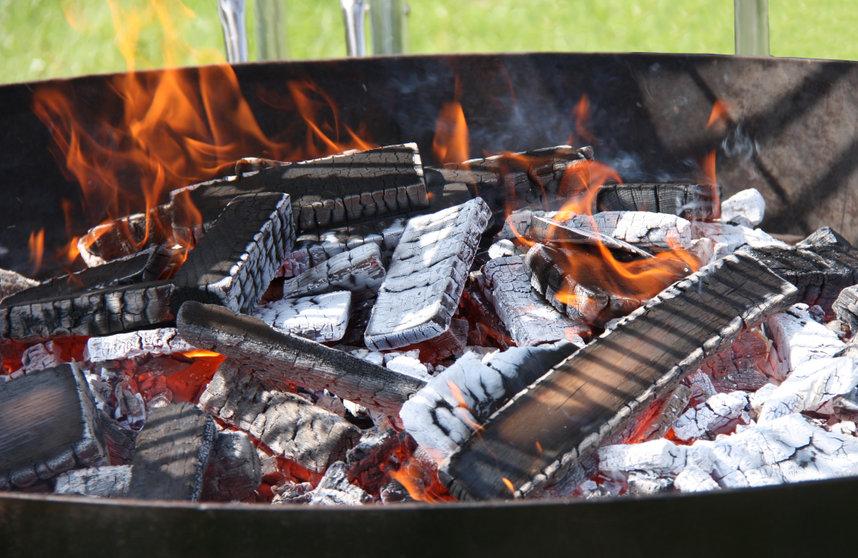
Safety should always be a top priority when grilling, especially when using charcoal.
Here are some best practices to follow.
- Choose a safe location for your charcoal grill. Place your charcoal grill on a stable, non-flammable surface away from any flammable objects such as buildings, trees, or overhanging branches. Make sure the grill is positioned on a level surface to prevent it from tipping over.
- Properly light and manage the charcoal. Follow the step-by-step guide for lighting and managing charcoal that we discussed earlier. Use a long-handled lighter or chimney starter to light the charcoal, and avoid using lighter fluid after the charcoal is already lit, as it can cause dangerous flare-ups.
- Use appropriate grilling tools. Use long-handled grilling tools to avoid getting too close to the hot charcoal or flames. Wear heat-resistant gloves or use grill mitts when handling hot grates, pans, or utensils.
- Keep a fire extinguisher or a bucket of sand nearby. In case of any emergencies, it’s essential to have a fire extinguisher or a bucket of sand readily available to quickly extinguish any flames. Never use water to extinguish a grease fire or charcoal fire, as it can make the situation worse.
- Be mindful of hot surfaces. Charcoal grills can become extremely hot, so always be cautious of hot surfaces. Avoid touching the charcoal, grates, or other parts of the grill without proper protection.
- Practice proper food handling. Follow food safety guidelines when handling raw meat. Wash your hands thoroughly before and after handling raw meat, use separate utensils and cutting boards for raw and cooked food, and avoid cross-contamination.
- Keep a watchful eye on the grill. Never leave your charcoal grill unattended, especially when there are open flames or hot charcoal. Keep a watchful eye on the grill at all times and be prepared to take action if needed.
- Allow the grill to cool down properly. After you’re done grilling, allow the charcoal and grill to cool down completely before attempting to clean or store them. Use caution when handling hot ashes or disposing of used charcoal.
By following these safety best practices, you can ensure a safe grilling experience and avoid accidents when cooking steak on charcoal.
Remember, safety first, and always exercise caution when grilling to protect yourself and others around you.
Bottom Line – Best Way to Grill Steak on Charcoal
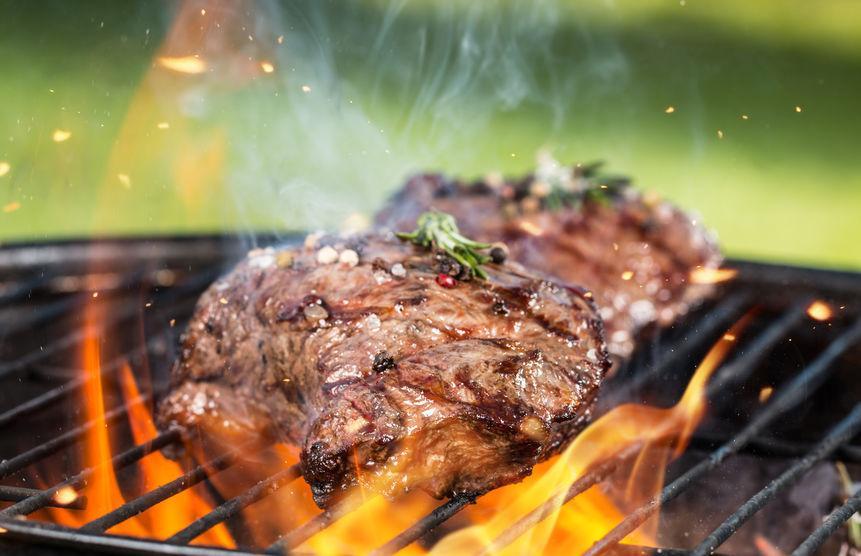
Grilling steak on a charcoal grill can be a rewarding and flavorful culinary experience.
By following the steps outlined in this guide, including selecting the perfect steak cuts, properly prepping your charcoal grill, using essential tools and ingredients, and prioritizing safety, you can create mouthwatering steaks with that distinct smoky flavor that charcoal grilling can offer.
With practice and patience, you’ll be able to impress your family and friends with perfectly grilled steaks that are sure to be a hit at your next barbecue

